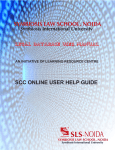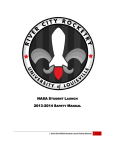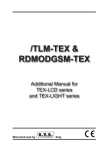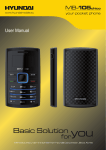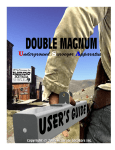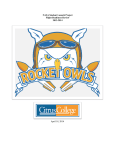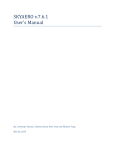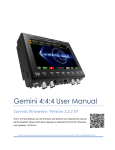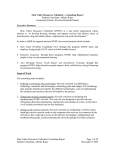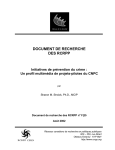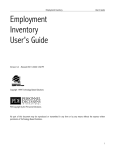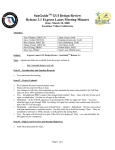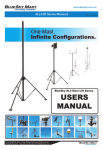Download NASA`s Space Grant Midwest High
Transcript
Handbook Version 3 – 3/25/2015 2014-2015 NASA’s Space Grant Midwest High-Power Rocket Competition Handbook Informational telecons: Tues. Sept. 23, 2014 (then repeated Thurs. Jan. 22, 2015) from 7 to 8 p.m. CST (contact James Flaten, MN Space Grant, for call-in information) Notice of Intent to Compete: Oct. 1, 2014 Registration Deadline: January 30, 2015 Launch Competition in Minnesota: Tues. & Wed., May 19-20, 2015 (Rain date: Thursday, May 21, 2015) Main contacts: James Flaten, [email protected], MN Space Grant Consortium, U of MN – Minneapolis Gary Stroick, [email protected], Tripoli MN (High-Power Rocketry Club) Web site: http://www.aem.umn.edu/mnsgc/Space_Grant_Midwest_Rocketry_Competition_2014_2015 Table of Contents Competition Objective ........................................................................................................ 3 Rocket Design Objectives ............................................................................................... 3 Judging Categories .......................................................................................................... 3 Competition Engineering Parameters ................................................................................. 4 Clarification Notes from FAQ Documents ......................................................................... 5 Competition Schedule ......................................................................................................... 8 Safety and Construction .................................................................................................... 10 Setting the Tone ............................................................................................................ 10 Presentation Format ...................................................................................................... 15 Evaluation Criteria ........................................................................................................ 15 Scoring Formula............................................................................................................ 15 Preliminary Design (Written) Report................................................................................ 16 Design Report Objective ............................................................................................... 16 Report Format ............................................................................................................... 16 Evaluation Criteria ........................................................................................................ 17 Scoring Formula............................................................................................................ 17 Flight Readiness (Written) Report .................................................................................... 18 Flight Performance........................................................................................................ 18 Test Flight Format......................................................................................................... 18 Evaluation Criteria ........................................................................................................ 18 Scoring Formula............................................................................................................ 19 Competition Flight ............................................................................................................ 20 Launch and Flight Format ............................................................................................. 20 Evaluation Criteria ........................................................................................................ 20 Post-Flight Performance Report ....................................................................................... 22 Performance Comparison.............................................................................................. 22 Performance Comparison Format ................................................................................. 22 Evaluation Criteria ........................................................................................................ 22 Scoring Formula............................................................................................................ 22 Educational Outreach ........................................................................................................ 24 Educational Outreach Performance .............................................................................. 24 Evaluation Criteria ........................................................................................................ 24 Scoring Formula............................................................................................................ 24 APPENDIX A-1............................................................................................................ 25 1|Page APPENDIX A-2............................................................................................................ 27 APPENDIX A-3............................................................................................................ 29 APPENDIX A-4............................................................................................................ 30 2|Page Competition Objective The Space Grant Midwest High-Power Rocket Competition is intended to supply student teams of affiliated universities with the opportunity to demonstrate engineering and design skills through practical application. Teams conceive, design, document, fabricate and compete with high-power rockets. The restrictions on rocket motors and dimensions are limited so that knowledge, creativity, and imagination of the students are challenged. The end result is a great aerospace experience for students that would not otherwise be available in the region. Rocket Design Objectives The objective of this year’s competition is as follows: Student teams will design and construct a high-power “boosted dart” that will be recovered safely and in flyable condition, predict its flight performance, collect look-down on-board video from the dart (during ascent configuration), and construct a non-commercial on-board data collection package for the dart that will characterize its rotation in the X, Y, and Z axes over time. Note that all fabrication work on the rocket (except for possible machining of plastic and/or metal parts) must be performed by students. Judging Categories Teams will be judged on their engineering acumen including, but not limited to, their design documentation, performance simulation, project construction and aesthetics, test plans and execution, launch and recovery operations including safety, as well as the demonstration of their rocketry knowledge and ability to communicate effectively. Teams will be evaluated based on their design reports, test flight results, presentations, competition flight, post-flight reports, as well as outreach activities. The total score for each student team will be based on the following parameters. Note: Outreach (described later) is also expected and there will be a 10% overall deduction if not performed before the Flight Readiness (Written) Report due date. Preliminary Design (Written) Report & Model Rocket Flight Documentation 30 Flight Readiness (Written) Report 10 Flight Readiness (Oral) Presentation 10 Competition Flight Performance 30 Post-Flight Performance Evaluation and Data Collection (Written) Report 20 Total 100 3|Page Competition Engineering Parameters Student teams will be required to design and fabricate a “boosted dart” rocket. A boosted dart has a rocket booster and an unpowered upper stage (the “dart”) which drag separates from the booster (no separation mechanisms that impart momentum to the dart are allowed) and coasts to apogee. Both the booster and the dart must be fin-stabilized with a static margin of one or greater and designed to land safely. The booster may use (a) just motor ejection or (b) electronic deployment with motor ejection backup. Note: ejection events are not permitted during booster ascent – they must occur at or after apogee. The booster will require a parachute recovery while the dart must use electronic deployment of a recovery system using a commercial rocketry altimeter that will safely land the vehicle. Depending on the dart’s size and weight, this might not necessarily be a parachute. All structural components and materials must be obtained from reputable high powered rocketry vendors or an engineering analysis demonstrating their suitability must be included with the design. The winner of the flight portion of the competition will be the team whose rocket completes a safe and successful flight and whose dart reaches the highest altitude and achieves the greatest separation between the dart and booster apogees, as recorded by a competition-provided flight recorder in each rocket section. Teams must collect down-looking on-board video from the dart (looking down during the ascent configuration) of their entire flight, including the boost phase. Teams must also construct a non-commercial data collection package for the dart to characterize its rotation in the X, Y, and Z axes, to compare with rotation seen in the on-board video. Apogee Separation 4|Page Clarification Notes from FAQ Documents 1. To distinguish a “down-looking” camera from an "out-looking" camera that just happens to have a very wide field of view, use the following empirical definition. “A down-looking camera will be defined as one in which the launch pad directly beneath the rocket (while in vertical flight) appears in the center 1/9th of the image if the image were to be divided into 9 equal sections by two vertical and two horizontal lines.” Note that it is also acceptable to use optical components to redirect the camera view, potentially allowing a sideways-oriented camera to be used to record look-down footage. The lower end of the rocket will obscure the down-looking view somewhat – this is to be expected. 2. Although “ejection events are not permitted during booster ascent” you may “deploy” something (like air brakes) just not “eject” something (like a parachute – not even a drogue chute) nor explosively force separation of the booster from the dart (that would violate the “don’t impart momentum to the dart” restriction) nor explosively separate the booster into pieces (to slow it down) before apogee. 3. The stability condition (i.e. “static margin of one or greater”) is a safety rule and applies to the booster + dart (from launch to burnout), to the dart alone (post separation, all the way to apogee), and to the booster alone (post separation, all the way to apogee). Safety decisions (associated with stability and more) will be made by the launch-site judges. If need be, the judges may use “instant replay” (i.e. ground video footage of the launch and/or on-board footage from the rocket itself) to assist them in making their decision. Rockets (or parts thereof) that go unstable during ascent, even unintentionally, will be subject to disqualification on safety grounds, even if they aren’t actually damaged. 4. Rockets will be disqualified (and receive 0 points for their Flight Performance score) if they do not fly safely. A safe flight is one in which the rocket (a) flies vertically (i.e. comes off the rail at an adequate speed), (b) flies stably (all parts, all the way to their respective apogees), (c) deploys recovery systems (both parts), (d) descends at a reasonable speed (both parts), and (d) is deemed flyable after landing and recovery. Notice that rockets that fail to separate during the ascent will not necessarily be deemed unsafe if they perform well otherwise, including deploying both recovery systems during descent. Notice that a “safe flight” is not synonymous with “doesn’t get damaged upon landing.” 5|Page Table 1. Competition Parameters Flight Mission Capture video and 3-axis rotational data over time from an unpowered boosted dart Booster Recovery Motor ejection required (primary or backup) Electronic ejection (optional) Parachute required Ejection of recovery parachute during ascent prohibited Other (non-ejection-based) braking systems allowed Dart Recovery Rocket Constraints Each team must prepare a mounting location for a competition Altimeter Two flight recorder in both their booster and their dart – make them accessible! Model Rocket Demonstration Flight Each team must purchase, assemble, fly, and successfully recover a “model” rocket. Pictures of the team at their launch site with the rocket, before and after their launch, must be included with the Preliminary Design Report. Teams whose members all have previous high-power rocket experience may request a waiver of this requirement or satisfy it with a (non-competition, i.e. non-boosted dart) high-power rocket launch instead. Required PreCompetition Test Flight Each team must assemble, fly, and successfully recover their fully-functional competition rocket prior to attending the competition. Here “fully-functional” means that it at least has booster and dart recovery systems fully operational. If you elect not to fly all of your other electronics (like the video camera and/or the rotation logger), replace them with dummy weights so the vehicle performance is as accurate as possible. It is recommended, although not required, that the rocket be flown on the competition motor (see below). The test flight must be performed using at least a high-power (Hclass) motor. Note: Teams considering test-launches with smaller-diameter motors than the competition motor might consider using a motor mount adapter in their design. Rocket Design and Safety Reviews Each team, with their rocket, must participate in the Safety Review the day before the competition launch. Additionally, we highly suggest having someone with Electronic ejection of a recovery system using a commercial rocketry altimeter required Dual deployment optional 6|Page extensive rocket safety experience (a Tripoli or NAR member) evaluate the safety of your design prior to and during the build process. o Analysis of non-“pre-qualified” components must accompany the rocket at the Design Safety Review. Each rocket must pass the Range Safety Officer’s Inspection the day of the launch, before it will be allowed to fly. Educational Outreach Successful Flight Each team must share information pertinent to aerospace with at least one non-rocketry group. For purposes of this competition, Outreach will be scored simply as "completed" or "not completed". Teams who do not complete the Outreach, as verified by their state’s Space Grant, will receive a 10% deduction from their final score. Launch Dart must separate from the booster during ascent Booster recovery system must successfully deploy Dart recovery system must successfully deploy Both sections of the rocket must be recovered in flyable condition See notes about “safe flight” on Page 5. Equipment provided by Competition: Required Competi Cesaroni 475-I445-16A (54mm, 1-grain, “Vmax”) tion Rocket Motor Thrust curve data can be found at: (one provided) http://www.thrustcurve.org/searchpage.jsp Dart Radio Tracking Competition Flight Data Recorders (two provided) (Optional (but highly recommended) since the dart will not leave a smoke trail and hence may be hard to follow by eye) Communication Specialties R-300 Tracking Receivers will be available to lend out, but teams will need to provide their own on-board radio transmitters. See http://www.com-spec.com/rocket/index.html Jolly Logic “Altimeter Two” (just a logger – not capable of firing ejection charges; internal battery) 1.93” long x 0.64” wide x 0.47” high 0.24 ounces (6.7 grams) These recorders are separate from the team's electronic deployment system(s) and will be inserted at time of launch into both the booster and the dart, to record altitude (and other data). 7|Page Additional Comments: Interested students with questions about the capabilities of the launch motors or seeking help in getting started are highly encouraged to contact Gary Stroick ([email protected]) of Tripoli Minnesota Association (a high-power rocketry association); or a rocket association near them. Students interested in gaining information or experience by observing rocket launches are encouraged to contact Gary or to attend one of the regular rocket launches held in North Branch, MN, by Tripoli MN or in their state. More information and launch schedules can be accessed at http://www.tripolimn.org and comparable websites elsewhere around the Midwest. Competition Schedule Teams will be required to adhere to the following schedule: Late August, 2014 – Announcement of rules September 23, 2014, 7 to 8 p.m. CST – Informational telecon (for teams starting in the fall) October 1, 2014 – (Non-binding) Notice of Intent to Compete and “sponsorship” by a Space Grant required of all teams, including those starting in the spring January 22, 2015, 7 to 8 p.m. CST – Repeat of informational telecon (for teams starting in the spring) January 30, 2015 – Formal Team Registration and payment of $400 registration fee February 13, 2014 – Declaration of Competition Attendance o Specify Number of Team Members Attending Launch o Specify Number of Hotel Rooms Required and Dates Required March 20, 2015 – Preliminary Design (Written) Report (see rubric below) o Also specify Number of Motors Needed – the registration fee covers the cost of one competition motor reload for the competition flight – additional motors (for the required test flight and/or to fly more than once at the competition) are the responsibility of the team and need to be declared in advance here (and purchased from a high-power rocketry vendor – extra motors can be delivered to the team at the competition itself by on-site vendors, if desired) o Also include Model Rocket Demonstration Flight Information Late April, 2015– Required test flight of “fully-functional” rocket – see Page 6 May 4, 2015 – Flight Readiness (Written) Report and Educational Outreach form due May 19-20, 2015 – Competition o Tuesday, May 19 – Late afternoon/Evening Flight Readiness (Oral) Presentations o Wednesday, May 20 – Competition Launch (North Branch, MN) and evening social event with announcement of partial results* o Thursday, May 21 – Alternative Competition Launch (Rain Date) May 29, 2015 – Post-Flight Performance Evaluation and Data Collection Report Final competition results will be reported on or before June 5, 2015. 8|Page Note that reports are due by e-mail at 5:00 p.m. central time on the dates specified above. Scores for late reports will be reduced by 20% for each portion of a day that they are late. * At this event we expect to announce, and celebrate, the top team in the Preliminary Design (Written) Report, the Flight Readiness (Written) Report, the Flight Readiness (Oral) Presentation, and maximum Dart-Apogee-Plus-Separation (if competition flights have occurred). We will also announce other (non-judged) milestones like (successful flight with) “Highest Dart Apogee” and “Lowest Booster Apogee” and “Top Speed at Burn-out” plus (peer-judged) milestones like “Best Paint Job” and “Coolest Design” and “Coolest On-board Video” and perhaps “Most Impressive Crash” (if any). Thus be sure to make plans to stay through the evening of May 20 so you can attend this event (and in case we need to move the flights to the Alternative Competition (Rain) Date). 9|Page Safety and Construction Setting the Tone It is understood that this experience may be the first time many of the competitors have designed, built and flown a high power rocket. To aid in making it a safe as well as educational aerospace opportunity, attention to safety will be held paramount. All teams will therefore be held to Code for High Power Rocketry as laid out in NFPA 1127 and further enhanced by the Tripoli Rocketry Association. Design and Safety Review Flight simulation showing max altitude and launch rail guide departure velocity (speed at 6 ft.) Preflight Safety Inspection Preflight Checklist Recovery/Postflight Checklist Table 2. FAA Model Rocket Classification Limitation Class 1 Class 2 Rocket weight Motor limit Altitude limit 1500 grams (3.3lbs) 4.4 oz. of fuel (mid-size H motors) None - may be set by local agreement. Clear of clouds (all classes) No limit 40960 N-sec total thrust No Limit FAA Waiver Required 5 miles visibility, Clouds less than 5/10ths coverage (Clear of clouds) FAA Waiver required and Notice to Airmen filed (NOTAM) Between Sunrise and Sunset Other Table 3. Tripoli Certification Requirements and Limitations Rocket / Motor Limitations Certification required Total Combined Impulse Combined propellant mass Single Motor Impulse Single Motor propellant mass Single Motor Average Thrust Sparky Motors Total Rocket Mass Field distance requirements None 320 N-sec (2 G Motors) 125 grams (4.4 oz.) 160 N-sec (G motor) 62.5 grams (2.2 oz.) 80 N-sec Not allowed 1500 grams (3.3 lbs) Per Model rocket safety code Level 1 HPR 640 N-sec (H,I) No Limit Level 2 HPR 5120 N-sec (J,K,L) Level 3 HPR 40960 N-sec (M,N,O) No Limit No Limit No Limit Allowed No Limit Per HPR safety code 10 | P a g e The purpose of NFPA 1127 the Tripoli Safety Code and the NAR Safety Code are to: Provide safe and reliable motors, establish flight operations guidelines and prevent injury. Promote experimentation with rocket designs and payload systems. Prevent beginning high power hobbyists from making mistakes. NFPA 1127 Code for High Power Rocketry National Fire Protection Association http://www.nfpa.org/1127 Tripoli Code for High Power Rocketry Tripoli Rocketry Association http://www.tripoli.org/LinkClick.aspx?fileticket=vF%2f34Qq57zg%3d&tabid=185 I. All Launches: A. Must comply with United States Code 1348, "Airspace Control and Facilities", Federal Aviation Act of 1958 and other applicable federal, state, and local laws, rules, regulations, statutes, and ordinances. B. A person shall fly a rocket only if it has been inspected and approved for flight by the RSO. The flier shall provide documentation of the location of the center of pressure and the center of gravity of the high power rocket to the RSO if the RSO requests same. C. The member shall provide proof of membership and certification status by presenting their membership card to the LD or RSO upon request. D. A rocket with a predicted altitude in excess of 50,000 feet AGL requires review and approval by the TRA Class 3 Committee. E. Recovery. 1. Fly a rocket only if it contains a recovery system that will return all parts of it safely to the ground so that it may be flown again. 2. Install only flame resistant recovery wadding if wadding is required by the design of the rocket. 3. Do not attempt to catch a high power rocket as it approaches the ground. 4. Do not attempt to retrieve a rocket from a power line or other place that would be hazardous to people attempting to recover it. F. Payloads 1. Do not install or incorporate in a high power rocket a payload that is intended to be flammable, explosive, or cause harm. 2. Do not fly a vertebrate animal in a high power rocket. G. Weight Limits 1. The maximum lift-off weight of a rocket shall not exceed one-third (1/3) of the average thrust on the motor(s) intended to be ignited at launch. H. Launching Devices 1. Launch from a stable device that provides rigid guidance until the rocket has reached a speed adequate to ensure a safe flight path. 2. Incorporate a jet/blast deflector device if necessary to prevent the rocket motor exhaust from impinging directly on flammable materials. I. Ignition Systems 11 | P a g e 1. Use an ignition system that is remotely controlled, electrically operated, and contains a launching switch that will return to "off" when released. 2. The ignition system shall contain a removable safety interlock device in series with the launch switch. 3. The launch system and igniter combination shall be designed, installed, and operated so the liftoff of the rocket shall occur as quickly as possible after actuation of the launch system. If the rocket is propelled by a cluster of rocket motors designed to be ignited simultaneously, install an ignition scheme that has either been previously tested or has a demonstrated capability of igniting all rocket motors intended for launch ignition within one second following ignition system activation. 4. A rocket motor shall not be ignited by a mercury switch or roller switch. J. Install an ignition device in a high power rocket motor only at the launch pad. K. Launch Operations 1. Do not launch with surface winds greater than 20 mph (32 km/h) or launch a rocket at an angle more than 20 degrees from vertical. 2. Do not ignite and launch a high power rocket horizontally, at a target, in a manner that is hazardous to aircraft, or so the rocket's flight path goes into clouds or beyond the boundaries of the flying field (launch site). 3. A rocket shall be pointed away from the spectator area and other groups of people during and after installation of the ignition device(s). 4. Firing circuits and onboard energetics shall be inhibited until the rocket is in the launching position. 5. Firing circuits and onboard energetics shall be inhibited prior to removing the rocket from the launching position. 6. When firing circuits for pyrotechnic components are armed, no person shall be allowed at the pad area except those required for safely arming/disarming. 7. Do not approach a high power rocket that has misfired until the RSO/LCO has given permission. 8. Conduct a five second countdown prior to launch that is audible throughout the launching, spectator, and parking areas. 9. All launches shall be within the Flyer's certification level, except those for certification attempts. 10. The RSO/LCO may refuse to allow the launch or static testing of any rocket motor or rocket that he/she deems to be unsafe. II. Commercial Launches A. Use only certified rocket motors. B. Do not dismantle, reload, or alter a disposable or expendable rocket motor, nor alter the components of a reloadable rocket motor or use the contents of a reloadable rocket motor reloading kit for a purpose other than that specified by the manufacture in the rocket motor or reloading kit instructions. C. Do not install a rocket motor or combination of rocket motors that will produce more than 40,960 N-s of total impulse. D. Rockets with more than 2560 N-s of total impulse must use electronically actuated recovery mechanisms. E. When more than 10 model rockets are being launched simultaneously, the minimum spectator distance shall be set to 1.5 times the highest altitude expected 12 | P a g e to be reached by any of the rockets. Tripoli Rocketry Association Safe Launch Practices F. When three or more rockets (at least one high power) are launched simultaneously, the minimum distance for all involved rockets shall be the lesser of: 1. Twice the complex distance for the total installed impulse. (refer to V. Distance Tables) 2. 2000 ft (610 m) 3. 1.5 times the highest altitude expected to be achieved by any of the rockets. G. When more than one high power rocket is being launched simultaneously, a minimum of 10 ft (3 m) shall exist between each rocket involved. MINIMUM DISTANCE TABLE Installed Total Impulse (NewtonSeconds) Equivalent High Power Motor Type Minimum Diameter of Cleared Area (ft.) Minimum Personnel Distance (ft.) Minimum Personnel Distance (Complex Rocket) (ft.) 0 -- 160.00 G or smaller N/A 30 30 160.01 -- 320.00 H 50 100 200 320.01 -- 640.00 I 50 100 200 640.01 -- 1,280.00 J 50 100 200 1,280.01 -2,560.00 K 75 200 300 2,560.01 -5,120.00 L 100 300 500 5,120.01 -10,240.00 M 125 500 1000 10,240.01 -20,480.00 N 125 1000 1500 20,480.01 -40,960.00 O 125 1500 2000 Note: A Complex rocket is one that is multi-staged or that is propelled by two or more rocket motors Design and Safety Review Endeavoring to have all teams perform their flights in a safe and controlled manner, each team must have the design and construction of their rocket reviewed in advance of the competition flight by a person holding at least a High-Power Rocket Level 2 Certification. The reviewer must not be associated with the team whose design is being reviewed in order to avoid a possible conflict of interest. A Safety Review Meeting will occur the evening before the competition launch date that will be mandatory for all teams. The teams must be prepared to discuss the design of their rocket and its systems. In addition, the teams must display: 13 | P a g e The team’s rocket in whatever state of assembly A diagram of the rocket indicating the configuration of its main components Flight simulation showing max altitude and launch guide velocity (speed at 6 ft) Deployment altimeter user manual Preflight Checklist Launch Pad and Flight Arming Checklist o Must include the altimeter’s ready/standby tones Recovery/Postflight Checklist o Must include procedure to “safe” unexploded deployment charges (if any) and turn off payload (if needed for safety reasons) Preflight Safety Inspection On flight competition day, all teams must have their rockets inspected before they will be allowed to proceed to the launch pad. The teams must be prepared to discuss their rocket’s design and its deployment systems. In addition, the teams must display: Team’s rocket readied for launch o Center of Gravity (CG) and Center of Pressure (CP) must be clearly marked on the rocket’s exterior Preflight Checklist (showing that all steps have been completed up to launch) Launch Pad and Flight Arming Checklist o Must include the altimeter’s ready/standby tones Recovery/Postflight Checklist o Must include procedure to “safe” unexploded deployment charges (if any) and turn off payload (if needed for safety reasons) Postflight Check-in Following the team’s competition flight the team must follow their Recover/Postflight Checklist to insure a safe recovery. The team then proceeds to the recovery check-in with: The team’s rocket Recovery/Postflight Checklist o Must show that all steps in the recovery procedure were completed before approaching the check-in station 14 | P a g e Flight Readiness (Oral) Presentation Presentation Format One or more team members will deliver the oral presentation to the judges. All team members who will deliver any part of the presentation, or who will respond to the judges’ questions, must be in the podium area when the presentation starts and must be introduced to the judges. Team members who are part of this “presentation group” may answer the judge’s questions even if they did not speak during the presentation itself. Presentations are limited to a maximum of ten (10) minutes. The judges will stop any presentation exceeding eleven (11) minutes. The presentation itself will not be interrupted by questions. Immediately following the presentation there will be a question and answer session of up to three (3) minutes. Only judges may ask questions (at first). Only team members who are part of the “presentation group” may answer the judges’ questions. If time allows there may be opportunity to take additional questions from the audience. If questions are taken from the audience, a designated presentation official will determine if the question is appropriate and, if so, allow the team to answer. Evaluation Criteria Presentations will be evaluated on content, organization, visual aids, delivery, and the team’s response to the judges’ questions. The scoring criteria are detailed in Appendix A-1 “Oral Presentation Judging.” The criteria are applied only to the team’s presentation itself. The team that makes the best oral presentation, regardless of the quality of their rocket, will score highest for the oral presentations. Scoring Formula The scoring of the Oral Presentation is based on the average of the Oral Presentation Judging forms. There is a maximum of 100 points from the Oral Presentation Judging form that will be scaled to meet the final score. 15 | P a g e Preliminary Design (Written) Report Design Report Objective The concept of this design report is to evaluate the engineering effort that went into the design of the rocket and how the engineering meets the intent of the competition. The document that illustrates the best use of engineering to meet the design goals and the best understanding of the design by the team members will score the highest. Report Format The design report can be no longer than twenty five (25) single-sided pages in length. It must be in a font not smaller than 12 pt and no less than single-spaced. All margins must be no less than 1 inch from the edge of the page. All pages (except for the cover page) must be numbered in the upper right hand corner. Each section of the report must be clearly delineated with a heading. All section headings must appear in a table of contents. Reports must be submitted electronically in .pdf format. 1 inch 1” 1” 1 inch Material that must be included, as a minimum: Separate Cover Page (counts toward page limit) Separate Table of Contents page (counts toward page limit) Separate Executive Summary page (counts toward page limit) Design Features of Rocket Design Features of Payload System (if any) Diagram of Rocket Identifying the dimensioned locations for the: - CP (center of pressure) for the booster, dart, and combined rocket - CG1 (center of mass with the fully loaded rocket motor) for the combined rocket - CG2 (center of mass after motor-burnout) for the booster, dart, and combined rocket Analysis of the Anticipated Performance – including how each were estimated - Estimated Maximum Altitude for the booster and dart (separately) 16 | P a g e - Estimated Peak Acceleration for booster and dart (separately) - Plot of Estimated Acceleration vs. Time for booster and dart (separately) Budget (planned, including (value of) Registration fee and Competition Travel) Evaluation Criteria Reports and design will be evaluated on content, organization, clarity, completeness, and professionalism of the material. The criteria are detailed in Appendix A-2 “Preliminary Design Report Judging.” Scoring Formula The scoring of the Preliminary Design Report is based on the average of the Preliminary Design Report Judging forms. There is a maximum of 100 points from the Preliminary Design Report Judging form that will be scaled for the final score. 17 | P a g e Flight Readiness (Written) Report Flight Performance The team will report on the success of the test flight including, but not limited to, the boost phase, dart separation, coast phase (booster and dart separately), and recovery system deployment of both the booster and the dart. Comparison of the fight performance to the predicted performance shall also be included to demonstrate the team's knowledge and understanding of the physics involved. It will be presented in the form of a brief report which shall include a discussion of the results, especially any differences between the actual and the predicted values. Test Flight Format The test flight document should follow the same guidelines as the Preliminary Design Report, no more than twenty five (25) pages in length, and must be submitted electronically in .pdf format. Material that must be included, as a minimum: Cover Page (counts toward page limit) Summary of Design (keep this to 5 pages or less) Budget (actual; with comments about changes since planned budget) Construction of Rocket (include photos) Photographs of Completed Rocket Test Flight Report - Boost Performance - Coast Performance (of booster and dart separately) - Separation Performance - Recovery System Deployment Performance (of booster and dart separately) - Table of Flight Characteristics - Plot: “Acceleration Performance Comparison of Predicted and Actual” Discussion of Results - Compare predicted and actual apogees, describe and defend possible reasons for differences - Compare predicted and actual peak velocities and peak accelerations, describe and defend possible reasons for differences (note: the flight values may come from an Altimeter Two and/or from the dart’s commercial altimeter) - Performance of on-board down-looking video and 3-axis rotation data-logging (optional, but encouraged – Table 1 now states that test flight(s) without both video and rotation logging are allowed, as long as recovery systems are fully operational – if you fly video or rotation logger, but not both, discuss its performance (even though you cannot do a comparison between the two)) Planned changes/improvements (if any) prior to competition flight Evaluation Criteria Reports will be evaluated on how closely the predicted results compare to the actual results, how well the team explains any differences, clarity, completeness, and professionalism of the material. The criteria are detailed in Appendix A-4 “Flight Readiness Written Report Judging.” 18 | P a g e Scoring Formula The scoring of the Flight Readiness Written Report is based on the average of the Flight Readiness Written Report Judging forms. There is a maximum of 100 points from the Flight Readiness Written Report Judging form that will be scaled for the final score. 19 | P a g e Competition Flight Launch and Flight Format The launch will take place at a site determined by Tripoli Minnesota (probably near North Branch, MN, which is about a 1-hour drive north of Minneapolis and St. Paul). Each rocket must pass a safety inspection before launch and any additional equipment must be cleared by the Range Safety Officer (RSO) before entering the launch area. The official flight data recorder will be placed in the rocket’s booster and dart sections by the altitude tracking official or designee or, minimally, proper placement and arming will be verified by such officials. Since Altimeter Twos can time out if they don’t detect a launch soon enough after they are armed, design your dart and booster so both Altimeter Twos can be armed and inserted easily just before launch (and reached to be re-armed fairly easily too, if need be). No more than five team members per Tripoli member may attend to the rocket once it is in the launch area. Each team must assemble a recovery team that will follow the directions of the RSO or designee. To be considered a successful flight, the rocket must: launch separate during the ascent deploy both booster and dart recovery systems safely land and be recovered in flyable condition Note: failure to record down-looking video and/or to record rotation data will not in and of itself constitute a failed flight. Flyable condition is defined to be that if the flyer were handed another motor, the rocket would pass RSO inspection and could be put on the pad and flow again safely. The entire rocket must be returned to a designated location for post-flight inspection by the RSO or designee. A flight performance report sheet will be filled out by a designated flight operations recorder. The flight operations recorder will record the data on the sheet during and following the flight. Upon completion, a team member must sign their initials of acceptance before a copy will be released to the team. Evaluation Criteria Finishing order for of the competition flight will based on: Having a safe flight (see notes on Page 6) Having a successful flight and recovery, as defined above Maximum altitude for dart as well as apogee separation for booster and dart Modified Scoring Formula Teams will score points based on the formula: Flight Score = 0 (AKA disqualification) if rocket is not recovered in flyable condition or if the flight is deemed “unsafe” or in violation of competition rules, even if the rocket is undamaged. This is at the judges’ discretion. Rockets may be disqualified for things like 20 | P a g e unstable ascent, too-fast descent, having explosive events during ascent (not allowed), not deploying both recovery systems, etc. Failure to separate on ascent will not be considered a reason for immediate disqualification if the rocket recovers properly (i.e. deploys both recovery systems on descent). Flight Score (if not disqualified) = 15 points (for having a safe flight) PLUS 42.5 points * (Dart Peak Altitude / Maximum Competition Dart Peak Altitude) + 42.5 points * ((Dart Peak Altitude – Booster Peak Altitude) / Maximum Competition Dart:Booster Separation Achieved) Notice that no less than 15 points will be awarded to rockets that safely fly and are recovered in flyable condition. There is a maximum of 100 points from the Competition Flight that will be scaled for the final score. If a rocket is flown multiple times during the competition, the best score will count (even if one score is a zero). However the Tripoli MN members running the launch might not allow launching a rocket that appears to them (in advance) to be fundamentally unsafe, so don’t expect to bend the safety limits with potential multiple flights. 21 | P a g e Post-Flight Performance Report Performance Comparison The comparison of the fight performance to the predicted performance will help to demonstrate the team's knowledge and understanding of the physics involved. It will be presented in the form of a brief report that will include a “Flight Performance Comparison Sheet” and discussion of the results, especially any differences between the actual and the predicted values. Performance Comparison Format The performance comparison document should follow the same guidelines as the Preliminary Design Report, no more than fifteen (15) pages in length, and must be submitted electronically in .pdf format. Material that must be included, as a minimum: Cover Page (counts toward page limit) Flight Performance Comparison Sheet - Table of performance characteristics (Table 4) – expand that generic table to suit the Boosted Dart flight profile - Plot: “Acceleration Performance Comparison of Predicted and Actual” (Figure 1) (optional plot – this request dates back to an earlier competition) Discussion of Results - Compare predicted and actual apogees, describe and defend possible reasons for differences - Compare predicted and actual peak accelerations and peak velocities. (Note: the Altimeter Twos will give peak acceleration and peak velocity, and other performance characteristics, so you don’t necessarily have to log acceleration and velocity separately to accomplish this), describe and defend possible reasons for differences - Compare logged rotation with rotation as seen in the video record (this may well include one or more graphs, but they are not explicitly required) - Optional – discuss other (optional) sensor data that was collected during the flight Evaluation Criteria Reports will be evaluated on how closely the predicted results compare to the actual results, how well the team explains any differences, clarity, completeness, and professionalism of the material. The criteria are detailed in Appendix A-3 “Flight Performance Judging.” Scoring Formula The scoring of the Post-Flight Performance Report is based on the average of the PostFlight Performance Report Judging forms. There is a maximum of 100 points from the Post-Flight Performance Report Judging form that will be scaled for the final score. 22 | P a g e GENERIC: FLIGHT PERFORMANCE REPORTING SHEET (not explicitly for Boosted Dart competition) SCHOOL Team 1 Operation (determined by RSO or designee) Launch Parachute deployment Recovered Determined to be in flyable condition Predicted Maximum Altitude (ft.) Table 4. Example of Flight Performance Characteristics Table (will have more entries for the Boosted Dart competition) ACCELERATION PERFORMANCE COMPARISON OF PREDICTED AND ACTUAL ACCELERATION (ft/s2) 2 Actual PREDICTED ACTUAL TIME (s) Figure 1. Example of Acceleration Performance Plot (for Boosted Dart competition, graphs of rotation are more likely) 23 | P a g e Educational Outreach Educational Outreach Performance An “Educational Outreach” element, in which each team shares information pertinent to aerospace with a non-rocketry group of at least 10 people, is expected. For purposes of this competition, outreach will be scored as "completed" or "not completed." Outreach possibilities could include, but are not limited to: Meet with a K-12 class or student organization to explain how rockets work. Make a presentation in the community or to a group on campus to describe this rocket competition and your team’s design. Make a presentation to a group on campus describing opportunities at NASA or through the state’s Space Grant Consortium that are available to students. Evaluation Criteria At the completion of the outreach event the team will need to have a representative at the event fill out and return to them an EPO (Education/Public Outreach) form that the team must then submit to their state’s Space Grant and to the competition organizers. Scoring Formula Teams that do not complete the Educational Outreach and submit their EPO form by the due date will receive a 10% decrease in their team’s overall score. 24 | P a g e APPENDIX A-1 SCHOOL Team FLIGHT READINESS ORAL PRESENTATION JUDGING Score the following categories according to the following scale (any number or fraction along this scale may be used). 0 = inadequate or no attempt ¼ Max Value = attempted but below expectation ½ Max Value= average or expected ¾ Max Value = above average but still lacking Max Value = excellent, perfectly meets intent _______ ENGINEERING & DESIGN CONTENT (25 pts) Discussion of Engineering Methodology (5 pts) Use of Design Tools (5 pts) Addressed Competition Objectives/Requirements (5 pts) Use of Analytical Data (5 pts) Description of Construction Techniques (5 pts) _______ ORGANIZATION (25 pts) Logical Organization & Structure (10 pts) Presentation Clarity (5 pts) Use of Visual Aids as Support Material (5 pts) Balance & Transitions Among Presenters (5 pts) _______ VISUAL AIDS (10 pts) Appropriate Use of Text (2 pts) Informational Charts & Illustrations (2 pts) Appropriate Design and Use of Graphics (2 pts) Use of Supporting Physical Materials (2 pts) Appropriate Use and Formatting of Slides (2 pts) _______ ROCKET APPERANCE (5 pts) Visual Appearance (2 pts) Quality of Construction (3 pts) _______ COMMUNICATION SKILLS (25 pts) Articulation (5 pts) Eye Contact (5 pts) Verbal Projection (5 pts) Body Language (3 pts) Poise/Presence (3 pts) Adherence to Time Constraints (4 pts) 25 | P a g e _______ QUESTION & ANSWER (10 pts) Active Listening Skills (4 pts) Answer Relevance (3 pts) Response Confidence/Persuasiveness (3 pts) TOTAL ORAL PRESENTATION POINTS (100 points maximum) COMMENTS: 26 | P a g e APPENDIX A-2 SCHOOL Team PRELIMINARY DESIGN REPORT JUDGING Score the following categories according to the following scale (any number or fraction along this scale may be used). 0 = inadequate or no attempt ¼ Max Value = attempted but below expectation ½ Max Value= average or expected ¾ Max Value = above average but still lacking Max Value = excellent, perfectly meets intent ________ ROCKET MECHANICAL & ELECTRICAL DESIGN (25 pts) Dimensional Specifications (2 pts) Recovery System Design Specifications (5 pts) Propulsion System Specifications (2 pts) Avionics System Design Specifications (5 pts) Planned Construction Solutions & Techniques (5 pts) Structural Analysis of Scratch-Built Parts (3 pts) Risk Mitigation Analysis (3 pts) ________ PREDICTED PERFORMANCE (25 pts) Launch Analysis (5 pts) Flight Analysis (5 pts) Recovery Analysis (5 pts) Stability Analysis (5 pts) Environmental Conditions Analysis (5 pts) ________ INNOVATION (15 pts) Uniqueness of Components/Systems (5 pts) Functional Relevance of Components (5 pts) Relevance to Competition Objectives (5 pts) ________ SAFETY (20 pts) Designed for Safe Flight & Recovery (5 pts) Documented Material-Handling Procedures (5 pts) Planned Assembly Procedures (5 pts) Planned Pre- & Post-Launch Procedures (5 pts) 27 | P a g e ________ REPORT AESTHETICS (10 pts) Followed Specifications (2 pts) Consistent Formatting (2 pts) Correct Spelling and Grammar (2 pts) Documented Figures and Graphs (2 pts) References and Labeling (2 pts) ________ TOTAL FLIGHT READINESS REPORT POINTS (100 points maximum) COMMENTS: 28 | P a g e APPENDIX A-3 SCHOOL Team POST-FLIGHT PERFORMANCE REPORT JUDGING Score the following categories according to the following scale (any number or fraction along this scale may be used). 0 = inadequate or no attempt ¼ Max Value = attempted but below expectation ½ Max Value= average or expected ¾ Max Value = above average but still lacking Max Value = excellent, perfectly meets intent ________ ROCKET OPERATION ASSESSMENT (30 pts) Flight Anomalies Analysis (10 or 0 pts) {If no anomalies, then points are distributed to remaining subsections} Propulsion System Assessment (4 or 6 pts) Flight Path Assessment (4 or 6 pts) Recovery System Analysis (4 or 6 pts) Rocket Location & Recovery Analysis (4 or 6 pts) Pre- & Post-Launch Procedure Assessment (4 or 6 pts) ________ ACTUAL VS PREDICTED PERFORMANCE (30 pts) Peak Altitude Comparison (10 pts) Peak Acceleration Comparison (10 pts) Peak Velocity Comparison (10 pts) ________ DATA COLLECTION (20 pts) Rotation Sensor Data Report (5 pts) (other sensors too, optional) Quality of On-board Video (5 pts) Data Interpretation/Comparison (10 pts) ________ REPORT AESTHETICS (20 pts) Followed Specifications (3 pts) Professionally Written (10 pts) Accurate Representation of Events (7 pts) ________ TOTAL POST-FLIGHT PERFORMANCE REPORT POINTS (100 points maximum) COMMENTS: 29 | P a g e APPENDIX A-4 SCHOOL Team FLIGHT READINESS WRITTEN REPORT JUDGING Score the following categories according to the following scale (any number or fraction along this scale may be used). 0 = inadequate or no attempt ¼ Max Value = attempted but below expectation ½ Max Value= average or expected ¾ Max Value = above average but still lacking Max Value = excellent, perfectly meets intent ________ RECAP OF ROCKET DESIGN (25 pts) Design and Dimensions (5 pts) Construction Techniques (5 pts) Stability Analysis (5 pts) Constructed for Safe Flight & Recovery (5 pts) Discussion of Changes Since Preliminary Design Report (5 pts) ________ ROCKET OPERATION ASSESSMENT (25 pts) Launch and Boost Analysis (5 pts) Coast Phase Assessment (5 pts) Separation Assessment (5 pts) Recovery System Analysis (5 pts) Pre- & Post-Launch Procedure Assessment (5 pts) ________ TEST LAUNCH ACTUAL VS PRED. PERFORMANCE (35 pts) Peak Altitude Comparison (10 pts) Peak Acceleration Comparison (10 pts) Peak Velocity Comparison (10 pts) Video and Rotation Data Logging Performance/Comparison (5 pts) (if intentionally not flown, discuss ground testing instead) ________ FINDINGS AND FUTURE WORK (10 pts) Key Findings (5 pts) Potential Design Improvements (5 pts) ________ REPORT AESTHETICS (5 pts) ________ TOTAL POST-FLIGHT PERFORMANCE REPORT POINTS (100 points maximum) COMMENTS: 30 | P a g e 2014-2015 NASA’s Space Grant Midwest High-Power Rocket Competition Education/Public Outreach Documentation Form The Minnesota Space Grant Consortium (MnSGC), on behalf of NASA, would like to thank you for giving our Midwest High-Power Rocket Competition participants a chance to provide educational outreach to your organization. Please take a moment to fill in some information below to verify the students’ participation. A portion of their competition score is based on their outreach activities so your willingness to let them present to you is appreciated. One main goal of Space Grant activities nationwide is to “raise awareness of, or interest in, NASA, its goals, missions and/or programs, and to develop an appreciation for and exposure to 1 science, technology, research, and exploration.” Space Grant Consortia in Midwest states promote science, technology, engineering, and math (STEM) fields through educational opportunities for college/university students, such as this rocket competition. We are also grateful for your involvement in this mission. If you have any questions about the Midwest High-Power Rocket Competition or about NASA’s Space Grant program, please contact the MnSGC, which is running this competition, by writing to [email protected], or else contact your state’s Space Grant Consortium directly. Web sites can be found at: http://www.nasa.gov/offices/education/programs/national/spacegrant/home/Space_Grant_Consortium_Websites.html Activity 1 (required) Activity 2 (optional) 1 – Source: Explanatory Guide to the NASA Science Mission Directorate Education & Public Outreach Evaluation Factors, Version 3.0, April 2008
































